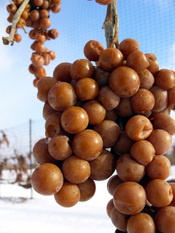By
Bryan Calandrelli, Niagara Escarpment Correspondent

One of the coolest parts about living in an area with a burgeoning wine region has to be the fact that you get to literally watch history unfold. Of course, some history takes place outside in the kind of cold that burns your lungs and freezes your eyeballs, but when I regain feeling in my fingers I’ll be able to look back on January 3 of this still-new year as the date that marks the first local harvest of ice wine grapes at not one but two local wineries. When temperatures dropped into the teens for two days earlier this month – long enough for the Vidal grapes on the vine to freeze solid — I got the call to be in the vineyard before sunrise for harvest.
Did I mention it was cold? For ice wine, there’s no other time to do it. There’s usually a narrow window of time within which wineries have to harvest and press these grapes. Even a slight, five-degree warm up into the twenties can affect the concentration of the pressed juice, and I quickly realized time is of the essence. Luckily, our area experienced an ideal two-day cold snap during which Schulze Vineyards and Winery (where I pitched in) and Niagara Landing became the first in the region to harvest and press grapes for what should be an exciting vintage for ice wine.
Even if you’re not familiar with the Niagara Escarpment region, you may well have heard of Niagara Peninsula, Niagara-on-the-Lake or Ontario wines — which means chances are you’ve heard of ice wine too. Usually packaged in 375ml bottles — with price tags quite often upwards of $90 for the half bottle — these wines are decadent, internationally sought after and critically acclaimed. Since the American Niagara region is only just across the Niagara River, the same general geology and climate extends in to the US side of the border.

Canadian wineries have been making world-class ice wines for decades now, and they seem to have the whole process down. On our side of the border, the wineries are learning as they go. Late in the growing season, the vines are prepared by placing netting around the rows to catch clusters if they fall from high winds or heavy precipitation. When I arrived (did I mention it was cold?), the wind was calm with light snow. It was extremely surreal to be out in a vineyard in these conditions. The only noise I could hear was the sound of frozen grapes hitting the bins below and the crunching of snow at my feet. The Canadian wineries do an excellent job of romanticizing the harvest, and I always thought that this was all marketing, but there is something very special about being there working in extreme conditions, on the one or two days of year and in only one of a few regions where nature can provide the conditions to make this unique wine.
As I tasted the grapes and drank the fresh juice from the first crush, I really got to thinking about the future of ice wine here. There’s every indication from what I tasted that this years ice wine vintage should make some exquisite wines. Even so, I often ponder how wine regions all over seem to grapple with identity issues with regards to the grapes that are cultivated within. Is Merlot Long Island’s signature grape? Well, yeah. So it only stands to reason that Riesling has to be the official grape of the Finger Lakes. Up here, there’s the pinot noir buzz. There’s the "well they can only make good white grapes cause it’s so cold" belief. And there’s always the hybrid and university-lab-engineered grape contingent. Well I’ll throw another log onto the fire. Could it be that in the near future if you’re drinking a Niagara Region wine, it might just turn out to be an American Niagara ice wine? That would be sweet.
